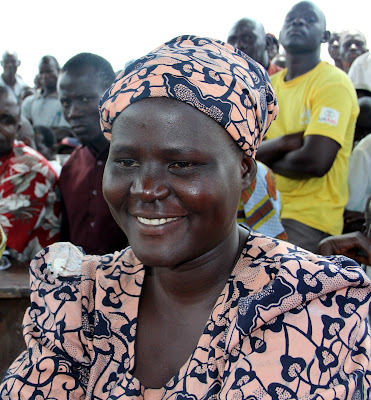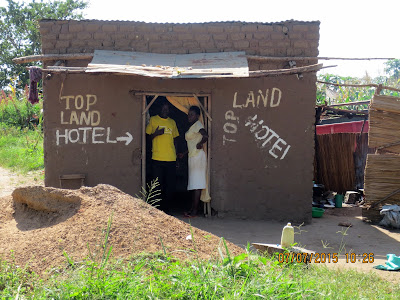I am afraid there will be many more videos this week because we got to play "dress up" and I wore a kanzu and Sister Squire wore a Gomesi (both are traditional dresses for special occasions). The special occasion was one of our assistants to the president (APs) was married and invited us to the wedding and introduction. He did it backward for Africa because he was married the day before the introduction. Usually, you have the introduction and then a church wedding after. The introduction can also serve as a wedding ceremony. This is one area where Africa really has gotten off track (in my view) with how a marriage should work. Here you pay Lobola or bride price for your wife. The groom has to come up with whatever negotiated amount (not cheap) the aunties can get out of him. For our past elder it was a dining room set, a whole bunch of individual gifts for all the family members, a rocking chair, money, roosters, a half a beef, a cow, and tons of commodities to cook with.
So a new couple either moves in together because they cannot afford to get married (the bride price) or they start off with a huge debt to pay along with trying to get schooling and raising a new family. Elder Dallin H. Oaks in March of 2012 gave a great talk called The Gospel Culture. Elder Oaks says this about bride price: "seriously interferes with young men and women keeping the commandments of the restored gospel of Jesus Christ. When a young returned missionary must purchase his bride from her father by a payment so large that it takes many years to accumulate, he is unable to marry or cannot do so until middle-aged. This conflicts with the gospel plan for sexual purity outside marriage, for marriage, and for child rearing." He goes on to say how the practice should be discontinued so young couples can get married and prepare for the temple and families. In this talk Elder Oaks praises many of the gospel traits that Africa symbolizes such as family loyalty and modesty.
There are other cultural traits that are contrary to gospel teachings. For instance the man rests while the woman does most of the work around the house and outside the home. The wife and children are more servants to the husband rather than a team working together.
In America, marriage is becoming an option, not a necessity. The family is the foundation on which all gospel principles are taught by word and by example. We cannot get away from it and have success as a nation.
Here is the bride (Carol) getting ready at the mission home before President Chatfield married them. Usually not allowed before the introduction ceremony. They did it backwards because they wanted to be married.
Sister Squire did another great job with the cake.
Look at those shoes!
Married at last.
Does this dress make my butt look fat? No, Elder but the rest of you sure does. This is the next day and everyone has to dress in traditional clothing. A Kanzu for men and Gomezi for women.
Sister Squire making friends with part of the booty.
President Chatfield runs cattle so he gravitated to the cow. The basket has some roosters for the family in it.
This is at Chris's home loading everything up before heading over to the party at the brides home.
A marked man.
I thought all along this was Chris mother but it turns out it is his aunt and neither mom is allowed to come to the ceremony. They are to stay home and pray everyone will accept the gifts offered as adequate.
The bride in her first change of clothing. Very fancy gomesi with lots of bead work.
Half way through we stop for eats. They have two MCs going back and forth all day, one for the bride side and one for the groom.
Here is the half of beef for the dowry. The leave one leg on so they know you aren't slipping some other type of meat past them.
Usually this would be the gifts for the new married couple. Not here, it is the price of giving up a daughter they have invested so much in.
The second change, an orange number. I didn't get a good picture of this one.
The third change, a regular looking dress.
This is the brides side and the guy with the mike is their MC.
This will be a lot of videos but I tried to capture the culture of this ceremony. In may ways it was very interesting (once) to see how formal and fun for those involved. They dance and banter back and forth the entire time. The women in pink are the Bridesmaids.
The girls in green are the teenage cousins.
The even got some white guy who really couldn't dance to come up. These are the older cousins in Yellow.
Sister Squire however really cut a rug (no idea what that means). These are the boy brothers and cousins. If some of these thin women seem to have a big booty, it is because they all pad their behinds. The men in Uganda find a women very attractive if they have a large behind.
These are the Aunties.
After dinner the presents are all brought in on top of the grooms family and friends heads.
These are some of the younger cousins.
I am glad I was able to support one of our great missionaries but once is enough for me. All day affair.











































































































